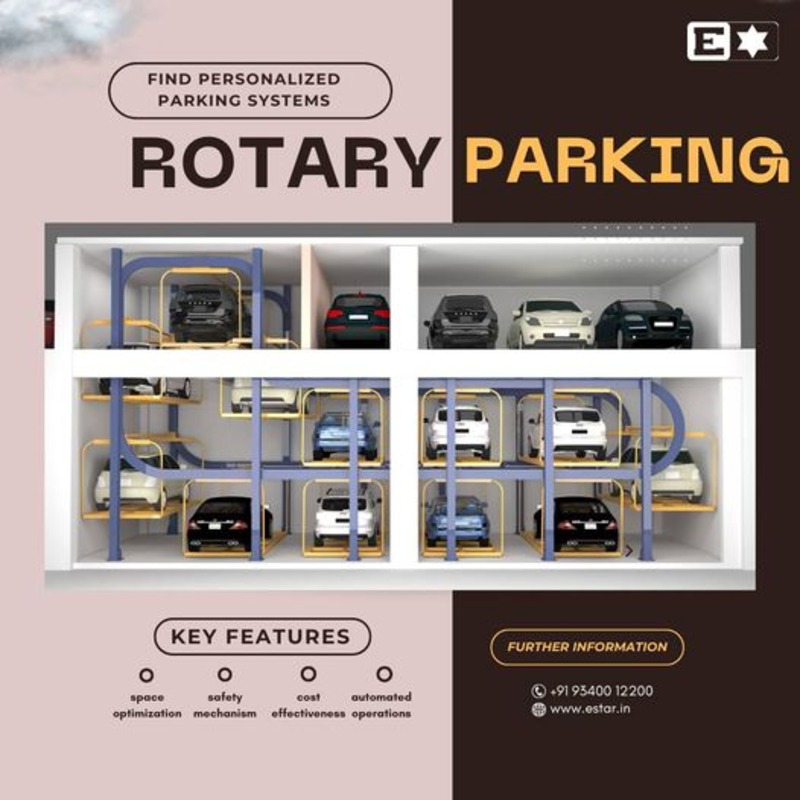Introduction to Rotary Parking Systems
The rapid urbanization of cities has created a pressing need for innovative parking solutions that optimize space usage. The rotary parking system is a game-changing technology that addresses parking space limitations by utilizing vertical space efficiently. This automated system provides a seamless way to park and retrieve vehicles in a compact area, making it an ideal solution for densely populated urban environments.
What is a Rotary Parking System?
A rotary parking system also known as a vertical rotary parking system, is a mechanical system designed to store multiple vehicles in a vertical, rotating structure. It operates on the Ferris wheel principle, where cars are parked on platforms that rotate in a circular motion. This design allows users to park and retrieve vehicles without complex maneuvers, saving time and reducing the hassle associated with traditional parking methods.
How Rotary Parking Systems Work
The system consists of a vertical rotating mechanism with platforms for vehicles. Here's how it operates:
-
Vehicle Entry:
The user drives the car onto an empty platform at ground level. Sensors ensure the car is positioned correctly. -
Platform Rotation:
The system rotates the platforms vertically, moving the car to an available parking slot. -
Vehicle Retrieval:
When the user requests their car, the system rotates to bring the platform holding the vehicle back to ground level for retrieval.
This automation ensures smooth and quick parking, minimizing human intervention.
Key Features of Rotary Parking Systems
-
Space Efficiency:
Rotary parking systems require minimal ground space, making them suitable for areas with limited parking capacity. -
High Capacity:
A single rotary parking system can accommodate multiple vehicles, maximizing the use of vertical space. -
Automation:
Fully automated operations eliminate the need for drivers to park manually, reducing errors and improving convenience. -
Eco-Friendly:
By reducing the land footprint and cutting down vehicle idling times, rotary parking systems contribute to lower carbon emissions. -
Safety:
Advanced sensors and locking mechanisms ensure the safety of parked vehicles.
Advantages of Rotary Parking Systems
1. Optimal Use of Space
Rotary parking systems utilize vertical space, making them perfect for urban areas where land is scarce and expensive.
2. Cost-Effective Installation
Compared to constructing multi-level parking structures, rotary parking systems are more economical and quicker to install.
3. Reduced Parking Time
The automated design minimizes the time required for parking and retrieving vehicles, enhancing user satisfaction.
4. Enhanced Security
With limited human access to the parking slots, the system ensures better security for vehicles against theft and damage.
5. Scalability
Rotary parking systems can be tailored to accommodate varying numbers of vehicles, meeting diverse business or residential needs.
Applications of Rotary Parking Systems
-
Residential Buildings:
Provides efficient parking solutions for apartment complexes where space is limited. -
Commercial Complexes:
Ideal for malls, offices, and retail spaces that need to accommodate a large number of vehicles. -
Hotels and Restaurants:
Ensures a smooth parking experience for guests, improving customer satisfaction. -
Hospitals and Clinics:
Offers quick and convenient parking for patients and visitors. -
Public Parking Areas:
Governments can use rotary systems to manage parking in busy urban zones effectively.
Comparison: Rotary Parking vs. Traditional Parking
| Feature | Rotary Parking System | Traditional Parking |
|---|---|---|
| Space Utilization | High | Moderate |
| Time Efficiency | Quick | Time-Consuming |
| Cost | Economical | Expensive |
| Automation | Fully Automated | Manual |
| Security | High | Moderate |
Technological Advancements in Rotary Parking Systems
With the advent of smart parking technologies, rotary parking systems have become even more efficient and user-friendly. Features like IoT integration, real-time monitoring, and mobile app connectivity allow users to check slot availability, book slots, and retrieve vehicles with a few taps on their smartphones.
Smart Features Include:
- Automated Payment Systems: Streamlines the payment process.
- Remote Access: Enables operators to manage and monitor the system remotely.
- Energy Efficiency: Incorporates energy-saving technologies to reduce operational costs.
Benefits for Urban Planning
Rotary parking systems play a crucial role in modern urban planning by:
- Reducing traffic congestion caused by inadequate parking.
- Enhancing the aesthetic appeal of crowded city spaces.
- Supporting green building initiatives with eco-friendly designs.
Challenges and Considerations
-
High Initial Costs:
Although cost-effective in the long run, the initial setup costs can be significant. -
Maintenance Requirements:
Regular maintenance is essential to ensure smooth and reliable operation. -
Limited Capacity:
While efficient, the capacity of a single rotary system may not meet the needs of extremely high-traffic areas. -
Height Restrictions:
Some urban areas may have zoning or height restrictions that limit the installation of tall structures.
Leading Providers of Rotary Parking Systems
E Star Engineers and other innovators have taken the lead in delivering cutting-edge rotary parking solutions. Their systems are known for reliability, customization, and advanced technology integration, making them a preferred choice for businesses and municipalities.
Conclusion
The rotary parking system is a revolutionary solution to the growing parking challenges faced in urban areas. Its space-saving design, automation, and user-friendly operation make it an indispensable part of modern infrastructure. As technology continues to evolve, rotary parking systems will further enhance the efficiency and sustainability of urban spaces.




